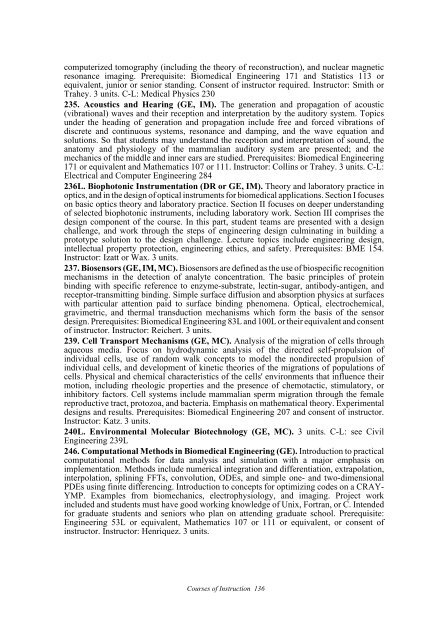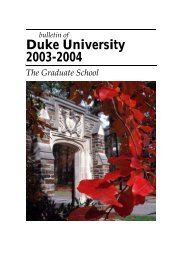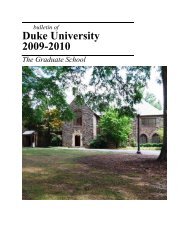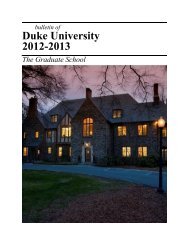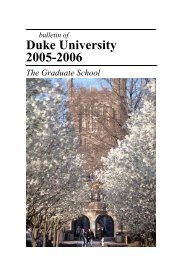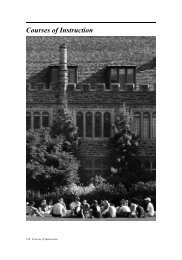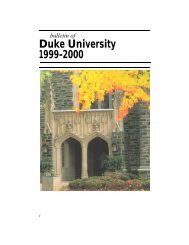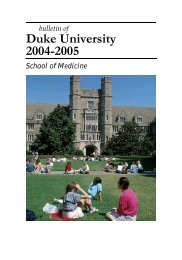Duke University 2008-2009 - Office of the Registrar - Duke University
Duke University 2008-2009 - Office of the Registrar - Duke University
Duke University 2008-2009 - Office of the Registrar - Duke University
You also want an ePaper? Increase the reach of your titles
YUMPU automatically turns print PDFs into web optimized ePapers that Google loves.
computerized tomography (including <strong>the</strong> <strong>the</strong>ory <strong>of</strong> reconstruction), and nuclear magnetic<br />
resonance imaging. Prerequisite: Biomedical Engineering 171 and Statistics 113 or<br />
equivalent, junior or senior standing. Consent <strong>of</strong> instructor required. Instructor: Smith or<br />
Trahey. 3 units. C-L: Medical Physics 230<br />
235. Acoustics and Hearing (GE, IM). The generation and propagation <strong>of</strong> acoustic<br />
(vibrational) waves and <strong>the</strong>ir reception and interpretation by <strong>the</strong> auditory system. Topics<br />
under <strong>the</strong> heading <strong>of</strong> generation and propagation include free and forced vibrations <strong>of</strong><br />
discrete and continuous systems, resonance and damping, and <strong>the</strong> wave equation and<br />
solutions. So that students may understand <strong>the</strong> reception and interpretation <strong>of</strong> sound, <strong>the</strong><br />
anatomy and physiology <strong>of</strong> <strong>the</strong> mammalian auditory system are presented; and <strong>the</strong><br />
mechanics <strong>of</strong> <strong>the</strong> middle and inner ears are studied. Prerequisites: Biomedical Engineering<br />
171 or equivalent and Ma<strong>the</strong>matics 107 or 111. Instructor: Collins or Trahey. 3 units. C-L:<br />
Electrical and Computer Engineering 284<br />
236L. Biophotonic Instrumentation (DR or GE, IM). Theory and laboratory practice in<br />
optics, and in <strong>the</strong> design <strong>of</strong> optical instruments for biomedical applications. Section I focuses<br />
on basic optics <strong>the</strong>ory and laboratory practice. Section II focuses on deeper understanding<br />
<strong>of</strong> selected biophotonic instruments, including laboratory work. Section III comprises <strong>the</strong><br />
design component <strong>of</strong> <strong>the</strong> course. In this part, student teams are presented with a design<br />
challenge, and work through <strong>the</strong> steps <strong>of</strong> engineering design culminating in building a<br />
prototype solution to <strong>the</strong> design challenge. Lecture topics include engineering design,<br />
intellectual property protection, engineering ethics, and safety. Prerequisites: BME 154.<br />
Instructor: Izatt or Wax. 3 units.<br />
237. Biosensors (GE, IM, MC). Biosensors are defined as <strong>the</strong> use <strong>of</strong> biospecific recognition<br />
mechanisms in <strong>the</strong> detection <strong>of</strong> analyte concentration. The basic principles <strong>of</strong> protein<br />
binding with specific reference to enzyme-substrate, lectin-sugar, antibody-antigen, and<br />
receptor-transmitting binding. Simple surface diffusion and absorption physics at surfaces<br />
with particular attention paid to surface binding phenomena. Optical, electrochemical,<br />
gravimetric, and <strong>the</strong>rmal transduction mechanisms which form <strong>the</strong> basis <strong>of</strong> <strong>the</strong> sensor<br />
design. Prerequisites: Biomedical Engineering 83L and 100L or <strong>the</strong>ir equivalent and consent<br />
<strong>of</strong> instructor. Instructor: Reichert. 3 units.<br />
239. Cell Transport Mechanisms (GE, MC). Analysis <strong>of</strong> <strong>the</strong> migration <strong>of</strong> cells through<br />
aqueous media. Focus on hydrodynamic analysis <strong>of</strong> <strong>the</strong> directed self-propulsion <strong>of</strong><br />
individual cells, use <strong>of</strong> random walk concepts to model <strong>the</strong> nondirected propulsion <strong>of</strong><br />
individual cells, and development <strong>of</strong> kinetic <strong>the</strong>ories <strong>of</strong> <strong>the</strong> migrations <strong>of</strong> populations <strong>of</strong><br />
cells. Physical and chemical characteristics <strong>of</strong> <strong>the</strong> cells' environments that influence <strong>the</strong>ir<br />
motion, including rheologic properties and <strong>the</strong> presence <strong>of</strong> chemotactic, stimulatory, or<br />
inhibitory factors. Cell systems include mammalian sperm migration through <strong>the</strong> female<br />
reproductive tract, protozoa, and bacteria. Emphasis on ma<strong>the</strong>matical <strong>the</strong>ory. Experimental<br />
designs and results. Prerequisites: Biomedical Engineering 207 and consent <strong>of</strong> instructor.<br />
Instructor: Katz. 3 units.<br />
240L. Environmental Molecular Biotechnology (GE, MC). 3 units. C-L: see Civil<br />
Engineering 239L<br />
246. Computational Methods in Biomedical Engineering (GE). Introduction to practical<br />
computational methods for data analysis and simulation with a major emphasis on<br />
implementation. Methods include numerical integration and differentiation, extrapolation,<br />
interpolation, splining FFTs, convolution, ODEs, and simple one- and two-dimensional<br />
PDEs using finite differencing. Introduction to concepts for optimizing codes on a CRAY-<br />
YMP. Examples from biomechanics, electrophysiology, and imaging. Project work<br />
included and students must have good working knowledge <strong>of</strong> Unix, Fortran, or C. Intended<br />
for graduate students and seniors who plan on attending graduate school. Prerequisite:<br />
Engineering 53L or equivalent, Ma<strong>the</strong>matics 107 or 111 or equivalent, or consent <strong>of</strong><br />
instructor. Instructor: Henriquez. 3 units.<br />
Courses <strong>of</strong> Instruction 136


